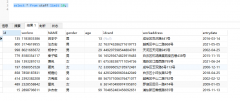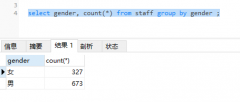Subqueries with EXISTS vs IN - MySQL(带有 EXISTS 与 IN 的子查询 - MySQL)
问题描述
下面两个查询是子查询.两者都是一样的,对我来说都很好.但问题是方法 1 查询执行大约需要 10 秒,而方法 2 查询需要不到 1 秒.
Below two queries are subqueries. Both are the same and both works fine for me. But the problem is Method 1 query takes about 10 secs to execute while Method 2 query takes under 1 sec.
我能够将方法 1 查询转换为方法 2,但我不明白查询中发生了什么.我一直试图自己弄清楚.我真的很想了解以下两个查询之间的区别以及性能提升是如何发生的?它背后的逻辑是什么?
I was able to convert method 1 query to method 2 but I don't understand what's happening in the query. I have been trying to figure it out myself. I would really like to learn what's the difference between below two queries and how does the performance gain happen ? what's the logic behind it ?
我是这些先进技术的新手.我希望有人能帮助我.鉴于我阅读了 docs 这没有给我任何线索.
I'm new to these advance techniques. I hope someone will help me out here. Given that I read the docs which does not give me a clue.
方法一:
SELECT
*
FROM
tracker
WHERE
reservation_id IN (
SELECT
reservation_id
FROM
tracker
GROUP BY
reservation_id
HAVING
(
method = 1
AND type = 0
AND Count(*) > 1
)
OR (
method = 1
AND type = 1
AND Count(*) > 1
)
OR (
method = 2
AND type = 2
AND Count(*) > 0
)
OR (
method = 3
AND type = 0
AND Count(*) > 0
)
OR (
method = 3
AND type = 1
AND Count(*) > 1
)
OR (
method = 3
AND type = 3
AND Count(*) > 0
)
)
方法二:
SELECT
*
FROM
`tracker` t
WHERE
EXISTS (
SELECT
reservation_id
FROM
`tracker` t3
WHERE
t3.reservation_id = t.reservation_id
GROUP BY
reservation_id
HAVING
(
METHOD = 1
AND TYPE = 0
AND COUNT(*) > 1
)
OR
(
METHOD = 1
AND TYPE = 1
AND COUNT(*) > 1
)
OR
(
METHOD = 2
AND TYPE = 2
AND COUNT(*) > 0
)
OR
(
METHOD = 3
AND TYPE = 0
AND COUNT(*) > 0
)
OR
(
METHOD = 3
AND TYPE = 1
AND COUNT(*) > 1
)
OR
(
METHOD = 3
AND TYPE = 3
AND COUNT(*) > 0
)
)
推荐答案
An Explain Plan 会告诉您为什么应该使用 Exists.通常问题是Exists vs Count(*).Exists 更快.为什么?
An Explain Plan would have shown you why exactly you should use Exists. Usually the question comes Exists vs Count(*). Exists is faster. Why?
关于NULL 带来的挑战:当子查询返回
Null时,对于IN,整个查询变成Null.所以你也需要处理它.但是使用Exist,它只是一个false.应付起来容易多了.简单的IN无法与Null进行比较,但Exists可以.
With regard to challenges present by NULL: when subquery returns
Null, for IN the entire query becomesNull. So you need to handle that as well. But usingExist, it's merely afalse. Much easier to cope. SimplyINcan't compare anything withNullbutExistscan.
例如Exists (Select * from yourtable where bla = 'blabla'); 当找到/匹配一个命中时,你会得到真/假.
e.g. Exists (Select * from yourtable where bla = 'blabla'); you get true/false the moment one hit is found/matched.
在这种情况下 IN 排序采用 Count(*) 的位置来选择 ALL 匹配行基于WHERE 因为它正在比较所有值.
In this case IN sort of takes the position of the Count(*) to select ALL matching rows based on the WHERE because it's comparing all values.
但也不要忘记这一点:
EXISTS对IN高速执行:当子查询结果非常大时.IN领先于EXISTS:当子查询结果非常小时.
EXISTSexecutes at high speed againstIN: when the subquery results is very large.INgets ahead ofEXISTS: when the subquery results is very small.
参考:
- 使用 IN 的子查询.
- IN - 子查询优化
- 加入与子查询.
这篇关于带有 EXISTS 与 IN 的子查询 - MySQL的文章就介绍到这了,希望我们推荐的答案对大家有所帮助,也希望大家多多支持编程学习网!
本文标题为:带有 EXISTS 与 IN 的子查询 - MySQL


基础教程推荐
- MySQL 5.7参照时间戳生成日期列 2022-01-01
- 带更新的 sqlite CTE 2022-01-01
- 带有WHERE子句的LAG()函数 2022-01-01
- 从字符串 TSQL 中获取数字 2021-01-01
- CHECKSUM 和 CHECKSUM_AGG:算法是什么? 2021-01-01
- 使用 VBS 和注册表来确定安装了哪个版本和 32 位 2021-01-01
- ORA-01830:日期格式图片在转换整个输入字符串之前结束/选择日期查询的总和 2021-01-01
- 如何在 CakePHP 3 中实现 INSERT ON DUPLICATE KEY UPDATE aka upsert? 2021-01-01
- MySQL根据从其他列分组的值,对两列之间的值进行求和 2022-01-01
- while 在触发器内循环以遍历 sql 中表的所有列 2022-01-01

















